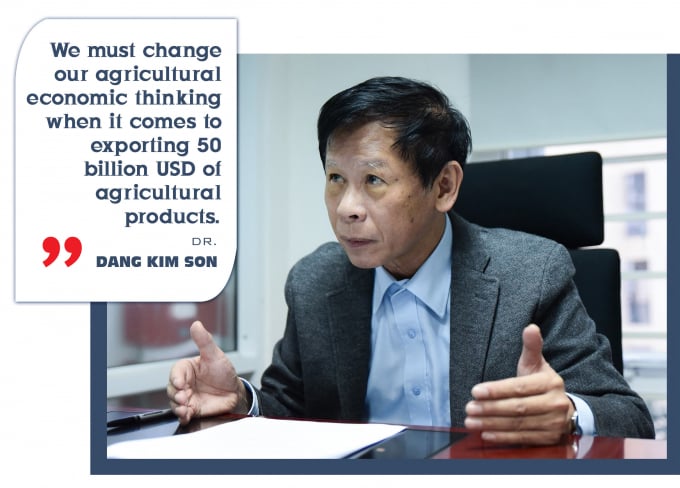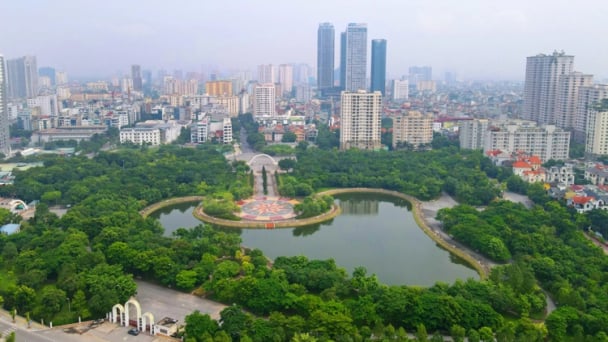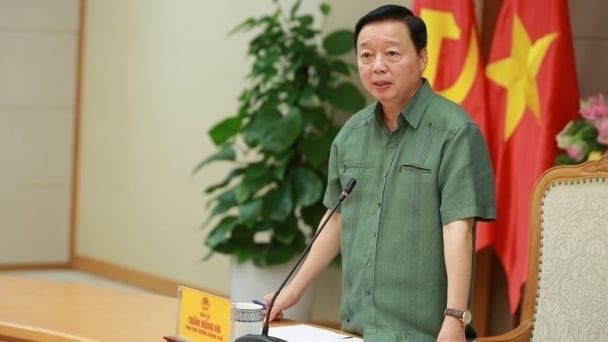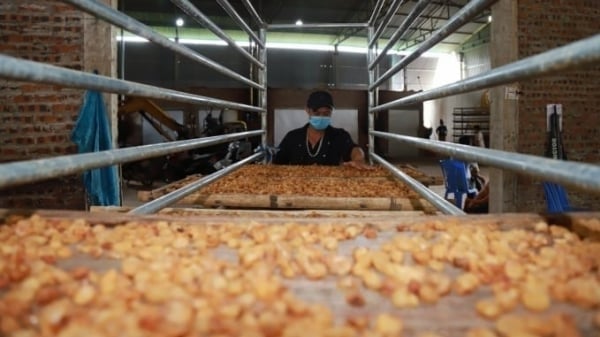May 21, 2025 | 07:02 GMT +7
May 21, 2025 | 07:02 GMT +7
Hotline: 0913.378.918
May 21, 2025 | 07:02 GMT +7
Hotline: 0913.378.918
Along with quicker changes domestically and internationally are many newly formed ideas: "organic agriculture", high-tech agriculture, circular agriculture,...; “smart farmer”, professions, start-up…; “modern countryside”, digitization, green, traditional…
Whenever we talk about agriculture, we think of fields, gardens, stables, fishing grounds, and forestry farms. And presently, when it comes to exporting 50 billion USD of agricultural products, agricultural economic thinking has expanded, including all transportation routes, warehouse areas, processing plants, even to supermarket chains, inter-industry, inter-regional, inter-national trading floors.
For a country with agricultural advantages, agriculture does not only include the livelihood of farmers but also the benefits and welfare of processing workers, traders, distributors... Cooperatives associated with businesses; small and medium businesses in association with large businesses; Large businesses in association with multinational enterprises, forming a complete organizational ecosystem. The concept of "economy" has linked agriculture with logistics services, trade and processing industry, and input material manufacturing industry both domestically and internationally.

In the future, the value of agricultural products is no longer calculated by the nutritional energy but will be expanded to promote health, prevent disease, beautification, improve stature, prolong age longevity. Buyers of agricultural products will pay more for concerns about social ethics, nature protection, cultural values, climate change prevention, etc.
Agricultural economic products include fresh agricultural products, processed products, waste, reused by-products, etc., and also from input materials such as fertilizers, pesticides, animal feed, agricultural machinery…
The mission of the multi-functional agricultural sector is to not only ensure food security, reduce hunger and poverty, serving as a pedestal for the country in difficult times, but also to support the manufacturing, processing, tourism and service industries, associated with the development of green environment, with the promotion of traditional culture, with the defense of the national security and contributions to humanity. That is multi-value agricultural thinking.
As income increases, consumers are past the problem of eating delicious food and now want to eat nutritious and valuable food instead. Products must integrate multiple nutritional, cultural, and environmental values, so agricultural production and export of agricultural products must be green, sustainable and humanely stable.
Conversely, the market also requires customers to be responsible towards producers, for them to enjoy fair trade, safe work, a healthy living environment, and guaranteed social policies. Markets also require pets to enjoy reasonable welfare, adequate living space, and freedom from abuse; Plants must be planted in areas where forests are not destroyed, and fisheries caught must have their renewable capacity protected.
And recently, agricultural production also comes with requirements to reduce carbon emissions, limiting the greenhouse effect to ensure the future of human society. Production is no longer simply a matter of scale and output, but a story of shared value and welfare for all parties.

Another aspect is sustainable agricultural thinking. We have destroyed many limestone mountains, dug up river sand, cleared many forests, fished and destroyed many beaches, dredged up open-cast coal, drained much groundwater, killed most wild animals, and are mining minerals, draining crude oil, building hydroelectricity... to get construction materials, generate export goods, achieve GDP growth target by consuming too much energy, by index of wasted investment capital, by low labor productivity... It is a way of living, to consume without taking into account the benefits of future descendants, and is less sustainable, both in terms of the natural environment and society nowadays.
During crises such as the Covid-19 pandemic, if there is no rural area for laborers to live in, there is no agriculture to produce food, to keep CPI low, fight inflation and export to ensure a safe environment. If the value of the Vietnamese currency is guaranteed, Vietnam's macroeconomy will not be safe, let alone the problem of the people. Agriculture is like an armor, the countryside is like a fortress for the country in difficult times. Sustainable development is the cheapest and most effective solution to ensure national security and stable development.
A lot can be said about new thinking such as organic agriculture, ecological agriculture, circular agriculture, high-tech agriculture, digital technology, smart agriculture... Not to mention the new mindset on farmers and rural areas. We have also changed a lot in our growth mindset. For example, in the Mekong Delta, there has been a consensus on the policy of favorable development from the principle of "living with floods" to "development of works according to no regrets", the nation has agreed to reduce the area of rice land to diversify agricultural production into fisheries and forestry, long-term crops. Shifting from thinking that forestry is to serve the environment to thinking that it is an economic sector, afforestation is combined with the processing industry to become a new export spearhead and rapidly increase Vietnam's forest cover rate, etc. However, the struggle of new thinking is not easy.
After the floods caused damage to hundreds of thousands of people in the 1990s, the Netherlands changed its thinking of conquering nature with dykes, sea embanks, and sluice gates to open up "river space", creating flood and inundated areas, adapting to extreme situations. New techniques and strategies learned from the Netherlands have helped Bangladesh reduce its recent record of flood casualties. However, the Dutch experts' proposal when planning the Mekong Delta to consider expanding phase 2 and 3 of projects to build Cai Lon - Cai Be system to avoid adverse environmental impacts is still controversial.
Another debate, which has lasted for 10 years, is the North-South high-speed railway with a speed of 350-320 km/h replacing luxury passenger planes without transporting goods. But recently, the China - Laos high-speed railway has been put into operation after 5 years of construction with a speed of 160 km/h, transporting both tourists and goods between the two countries in half a day. Freight costs are reduced by 30-40%, opening an important advantage for Thailand if they connect with this route to compete with Vietnamese agricultural products.
It is true that in the modern economy, agricultural production only accounts for about 5-7% of GDP, the rural population only accounts for about 5-10% of the whole economy involved. In the next 15-20 years, in areas with advantages such as the Mekong Delta or the Central Highlands, agriculture can still become the main sector, other industries must support, promote its role and take it to develop themselves. In order for Vietnam to become "the world's field", "the world's kitchen", agriculture cannot be an industry that must be sacrificed to serve industry and services.
The role of Vietnam's agriculture in the future is not only the foundation and support as in the past, but also the driving force, the core of the economy, promoting industry and services to become an advantage of the country.
Our strength lies in the wonderful tropical nature. Despite extreme climate change, there are still sustainable production areas with enough labor and water resources. Most raw agricultural products must be deeply processed, including by-products. Agricultural products can be transformed into functional foods, medicines, garment materials, handicraft materials, etc.
We have to sell agricultural machinery, agricultural processing machines... Laborers for export must be gardeners, fishermen, bonsai caretakers, grafters, and cooks...The reality of Israel, the Netherlands and other countries that develop agriculture based on high technology and close organization shows that the investment rate per unit area of modern agriculture, the productivity of advanced agriculture is equivalent to that of the industry and service sector.
Translated by Nguyen Hai Long

(VAN) Dong Thap farmers attained an average profit margin of 64% during the summer-autumn 2024 crop (first season), while An Giang and Kien Giang farmers followed with 56% and 54%, respectively.

(VAN) As a doctoral student doing research on renewable energy and electrification at Harvard University, the author shares his musings on electricity, nature, and countryside memories.

(VAN) The decree on Extended Producer Responsibility (EPR) ensures transparent management and disbursement of support funds, avoiding the creation of a “give-and-take” mechanism.

(VAN) Hue City rigorously enforces regulations regarding marine fishing and resource exploitation, with a particular emphasis on the monitoring of fishing vessels to prevent illegal, unreported, and unregulated (IUU) fishing.

(VAN) Hanoi People's Committee has issued a plan on reducing greenhouse gas emissions in the waste management sector with 2030 vision.

(VAN) Vietnam's draft amendment to Decree No. 156 proposes a mechanism for medicinal herb farming under forest canopies, linking economic development to population retention and the sustainable protection and development of forests.

(VAN) In reality, many craft village models combined with tourism in Son La have proven effective, bringing significant economic benefits to rural communities.